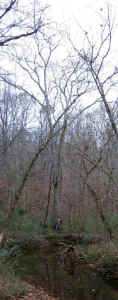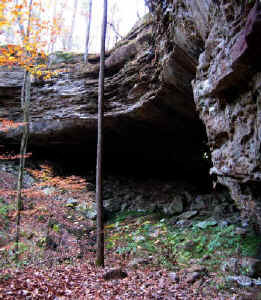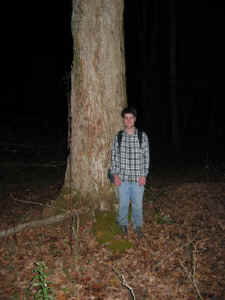A few weeks ago, Will Blozan and I visited two impressive
hardwood
forests sites within the Bankhead National Forest (NF). Located
in
northwestern Alabama, the Bankhead NF occupies approximately
180,000
acres of the Cumberland Plateau's southern end. Erosion of the
Plateau's sandstone and limestone by numerous small streams has
left a
highly dissected landscape with broad, flat-topped ridges, and
narrow,
cliff lined hollows or box canyons. Those canyons and their
associated waterfalls have made the Bankhead's Sipsey Wilderness
one
of the best-known wilderness areas in the southeast. Fields,
tree
plantations, and abandoned agricultural land occupy much of the
flatter surrounding landscape
(http://gorp.away.com/gorp/resource/us_national_forest/al_bankh.htm).
The canyons, with their cool moist microclimates, offer many
organisms
a refuge from the region's hot summers. Eastern hemlock reaches
the
southwestern limits of its range in the canyons, and the low
wind
environment allows the usually uncommon bigleaf magnolia
(Magnolia
macrophylla) to maintain the largest simple leaves in temperate
North
America, frequently over two feet long. The overhangs and wet
cliffs
at the top of the gorges also provide habitat for several rare
herbaceous species, and have sheltered humans for thousands of
years.
 Flint Creek Sugarberry - photo by Will Blozan
Flint Creek Sugarberry - photo by Will Blozan
We first visited West Flint Creek. One of the larger streams
flowing
north out of the Bankhead NF, moderate slopes rather than shear
cliffs
flank the watercourse although low bluffs of eroded limestone
still
protrude from the lower slopes. Sandstone, which occasionally
formed
smaller outcrops, supported much of the curving, generally
northwest
facing, 200' high slope we roamed. The aptly named walking fern
(Asplenium rhizophyllum) clung to the sandstone boulders, and
overlooked allegheny spurge (Pachysandra procumbens), the site's
primary evergreen herbaceous species. Red buckeye (Aesculus
pavia)
formed sometimes-extensive colonies in the understory under a
largely
oak and hickory dominated canopy. Sweetgum, tuliptree, basswood,
florida maple (Acer barbatum), and locally beech also commonly
reached
the canopy. Shagbark and pignut were the dominant hickories
while
white was likely the most common oak.
A surprisingly broad floodplain with mature bottomland hardwoods
also
bordered the stream. American bladdernut and river cane grew in
patches below tuliptree, sweetgum, sycamore, bitternut hickory,
sugarberry, and patches of cottonwood and loblolly pine.
Sweetgum and
tuliptree appeared to achieve similar growth rates in the
floodplain
as on the slope.
Species Cbh Height
Ash, Green 8'9.5" 119.3'
Basswood, White 5'7" 121.9'
Basswood, White 9'6.5" ~125'
Blackgum 6'0" 114.5'
Cherry, Black 5'5.5" 105.1'
Cottonwood 14'2" 124.7'
Cottonwood 8'11" 132.5'
Cottonwood 6'10" 133.8'
Cottonwood 10'10" 136.7'
Cucumbertree 5'2" 112.4'
Cucumbertree 7'11" 112.6'
Hickory, Bitternut 7'10" 114.0'
Hickory, Bitternut 6'3" 120.4'
Hickory, Bitternut 6'4" 126.9'
Hickory, Pignut 6'11.5" 133.2'
Hickory, Shagbark 6'5" 131.2'
Hickory, Shagbark 5'0" 133.0'
Hickory, Shagbark 6'10" 139.9'
Honeylocust 5'5" 97.1'
Honeylocust NA 102.0'
Hornbeam, American 3'5" 62.6'
Maple, Florida 6'6" 97.8'
Maple, Florida 4'10" 107.8'
Maple, Florida 3'8" 110.0'
Maple, Florida 5'5" 114.8'
Oak, Black 7'5" 118.3'
Oak, Chinquapin 4'3" 102.3'
Oak, Northern Red 8'4" 127.1'
Oak, Northern Red 7'7" 132.1'
Oak, Northern Red 10'4" 137.6'
Oak, Shumard 9'9" 125.5'
Oak, Shumard 6'7" 125.6'
Oak, Shumard 9'0' 128.3'
Oak, Shumard 6'4" 137.3'
Oak, Shumard 7'9.5" 137.3'
Oak, Water 6'0" 120.8'
Oak, White 12'2" 124.8'
Oak, White 7'5" 128.3'
Pine, Loblolly 8'2" 142.8'
Pine, Shortleaf NA 118.1'
Redcedar, Eastern NA 96.3'
Sugarberry 129 97.9'
Sugarberry 7'3" 117.4'
Sweetgum 7'2" 133.0'
Sweetgum 5'7" 136.7'
Sycamore 7'3" 120.6'
Sycamore 5'2" 134.6'
Tuliptree NA 128.6'
Tuliptree 7'3" 136.4'
Tuliptree NA 138.1'
Tuliptree 7'0" 138.7'
Tuliptree NA 139.7'
Tuliptree 7'7.5" 139.9'
Tuliptree NA 144.7'
Walnut, Black 7'3" 113.7'
Walnut, Black 6'4" 117.1'
Walnut, Black 5'8" 118.4'
Rucker Index 137.2'
Tuliptree 144.7'
Loblolly Pine 142.8'
Shagbark Hickory 139.9'
Northern Red Oak 137.6'
Shumard Oak 137.3'
Sweetgum 136.7'
Cottonwood 136.7'
Sycamore 134.6'
Pignut Hickory 133.2'
White Oak 128.3'
For all of those species, ENTS had no height records for
Alabama, or
only had records from the preceding day. The blackgum height is
comparable to other heights in the region.
 Flint Creek Cottonwood - photo by Will Blozan
Flint Creek Cottonwood - photo by Will Blozan
The Cottonwood is now
the
tallest known in the east by 0.7'. Cottonwoods growing in
approximately 100 year-old forests in the southeastern piedmont
consistently reach 133 to 137'; similar heights have also been
found
in Missouri, Michigan and New York. The shagbark hickories are
about
10' short of the greatest height they are known to reach, but
all of
the sites with taller individuals have more topographical relief
and
shelter from winds. ENTS has a paucity of data on honeylocust,
but
this tree is similar in height to honeylocusts recently measured
in
Tennessee. The florida maples at this site shatter the previous
ENTS
height record of 94.4'. The shumard oaks approach the tallest
ENTS
has thus far documented, and all taller individuals have grown
on
floodplain sites. The redcedar also easily surpasses the
previous
eastern height record, an 89.7' tree in Tennessee. The tree
grows on
a small limestone bench near the creek. The calcium rich
substrate,
low statured forest immediately upslope, and the reliable water
supply
offered by the location seem nearly ideal for the species. The
sugarberry was also a new eastern height record at the time it
was
measured. The range of heights in the Rucker Index is remarkably
small, and suggests the tallest species do not have height-based
niches at the site.

Indian Tomb Hollow shelter - photo by Will Blozan
|
 |
With the light already waning, we left West Flint Creek and
headed for
the forests of Indian Tomb Hollow. A long, bumpy, dirt road; a
low
gap; and a surprisingly gentle slope permitted access to the
hollow.
Opposite the gap, sandstone cliffs, perhaps 60 feet high,
clearly
demarcated the far side of the hollow. Mountain laurel, big leaf
snowbell (Styrax grandifolia) and chestnut oak grew at the foot
of the
cliff. White oaks, chestnut oaks, northern red oaks, hickories
and
beech constituted much of the overstory, and patches of bigleaf
magnolia grew prominently in the midstory. Moving up the hollow,
the
stream forked repeatedly, and continuous cliffs loomed along
both
sides. After two months of drought, only a trickle of water
flowed
over the shelf-like overhang at the top of the canyon. However,
the
influences of the greater water availability and maximized
sheltering
clearly contributed to the occurrence of the tallest forest at
that
location.
 Tall Chestnut Oak, Indian Tomb Hollow -
Tall Chestnut Oak, Indian Tomb Hollow -
photo by Will Blozan
Species Cbh Height
Cucumbertree 8'9" 115.2'
Magnolia, Bigleaf 4'0" 83.3'
Magnolia, Bigleaf 3'1" 83.8'
Maple, Florida 8'7" 96.4'
Oak, Chestnut 7'11" 136.5'
Oak, Chestnut 7'5" 141.8'
Oak, Swamp Chestnut8'7" 119.5'
Oak, White NA 129.9'
Sassafras 2'8" 87.5'
The bigleaf magnolias approach the heights ENTS has found for
the
species in Georgia. The box canyons hold great promise for many
more
large and tall bigleaf magnolias.
 Florida Maple, Indian Tomb Hollow
Florida Maple, Indian Tomb Hollow
- photo by Will Blozan
The florida maple is a
semi-open
grown specimen on an adjacent slope outside the canyon. The
chestnut
oaks grow adjacent to the large overhang at the upper end of the
hollow. They benefit from local maxima of both sheltering and
water
supply. The physiological effects of that environment might be
seen
in that the height of their branching coincides with the top of
the
cliffs. The taller of the two comes within two feet of the
greatest
height ENTS has found for this heavily sampled species.
We would like to thank Dr. Larry Brasher for his efforts in
organizing
the trip and aid with species identification and Lamar Marshall,
head
of the environmental group Wild Alabama, for his excellent
guidance
through the sites. Within the past few years, Wild Alabama
identified
these areas of unusually mature hardwood forest and took some
preliminary core samples.
Jess Riddle & Will Blozan
|